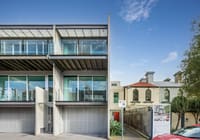
The $325 billion funds giant keen on Australian housing
Rental housing will emerge as one of the largest single classes within the commercial property sector as the “great reset” sparked by higher interest rates reshapes investment for years to come, according to one of the world’s largest investors, PGIM Real Estate.
That’s the view of Raimondo Amabile, who oversees $US210 billion ($325 billion) in assets under management globally, in his role as the platform’s co-chief executive officer and global chief investment officer.

It’s an insight that carries considerable weight – including for Australia – as it guides the strategy of PGIM Real Estate, the world’s third-largest property investment house.
“If you ask me what would be the sector not only for us but also for the institutional investors going forward for the next 10 years, 20 years, it is residential for renting – and [residential] living in general, whether it’s build-to-rent, or student housing, or senior living – which will be very much a growing part of portfolio allocation,” Mr Amabile told The Australian Financial Review in a video call from Singapore.
Were it not for a cancelled flight, Mr Amabile would have made it to Australia, where PGIM Real Estate is already making brisk progress on that strategy through its focus on affordable rental housing.
Two months ago, PGIM Real Estate teamed up with the founders of modular hotel chain Tribe to create a portfolio of co-living facilities worth as much as $750 million.
Their venture is up and running, with seed assets secured in Brisbane’s Fortitude Valley and in Sydney’s Parramatta. Each facility will comprise about 300 smaller-scale apartments. The longer-term ambition is to expand into more facilities with a portfolio of between 1250 and 1500 apartments.
“As part of the great reset that we’re experiencing is the fact that [the] office [sector] is becoming less relevant in the portfolio allocation of these investors. Actually, they’re decreasing their exposure,” Mr Amabile said.
“These flows will likely go into the residential for renting sector, which probably will represent one of the largest, if not the largest, asset class in the world.”
PGIM is the global asset management business of New York-listed Prudential Financial, which has $US1.27 trillion ($1.95 trillion) in funds under management.
In Australia, its property arm PGIM Real Estate has about $3 billion in equity and debt mandates across logistics, office, retail, hotels, data centres and mixed use. Its exposure to housing is various: from build to sell, land lease communities, student housing and seniors living.
Underpinning the PGIM Real Estate chief’s view is both an analysis of conditions – a higher cost of capital, a liquidity squeeze and a looming deceleration in rental growth – and the factors that will shape the real estate landscape into the future. Those are conveniently grouped as the “three Ds” of digitisation, demography and decarbonisation.
Rental housing lies smack in the middle of those overlapping frameworks.
The key lies in housing’s ability to deliver rental growth as income becomes an increasingly important component of total return in the real estate sector.
As Mr Amabile tells the story, the property sector had an easy run out of the global financial crisis, as progressively lower interest rates brought lower capitalisation rates – the sector’s metric for expected investment yield – applied to real estate assets. That trend in turn pushed up valuations, adding capital growth to returns.

Even if, as some analysts overseas are foreshadowing, cash rates have peaked and the case for some loosening monetary policy is already emerging, it is income not capital growth that will define property returns, he said.
“Our strong conviction, as we are going into this new crisis, is that we’re not going to see cap rate compression driving huge value increases,” Mr Amabile said.
“It will be a totally different story when it comes to what the total return is going to look like.
“There are two things which we’re really focusing on: one is the resilience of the income, on income which is underpinned by very strong fundamentals, driving its sustainability in the long run.
“The other major factor is how can you grow your income, grow your cash flow to then drive operational efficiency and NOI (net operating income) growth.
“These are the two main drivers of our investment strategy. So, when it comes to housing, there is a perfect fit. It comes into a demographically driven investment thematic. Residential for rent is a very good example.”
Meanwhile, a slowing in rental growth across commercial real estate is already apparent. Mr Amabile expects that deceleration will propel a “second leg” in decreasing valuations.
The slowdown is most evident in the office sector, where rising cap rates have already hit values hard. Up to 40 per cent could ultimately be stripped from office valuations in Europe, 30 per cent in the US, and around 15 to 20 per cent in Australia, according to Mr Amabile.
But it’s also a factor to be noted in the logistics sector, which has so far proven relatively resilient. Australia’s industrial sector has been immune so far, courtesy of tight supply and historically low vacancy rates buoying rental growth. Yet, while overall PGIM is bullish on logistics, Mr Amabile warns of a looming bifurcation, where warehouses in worse locations will suffer as a slowing economy reduces demand.
Most at risk, though, according to Mr Amabile, remain secondary office towers.
“I can tell you that in places like Europe and the US, we definitely underestimated, to some extent, the pace at which secondary assets are becoming stranded assets.
“When it comes to Australia, bifurcation is happening here. This stranded assets [theme] will play out in Australia. We should not underestimate it, this can go super-fast.”











